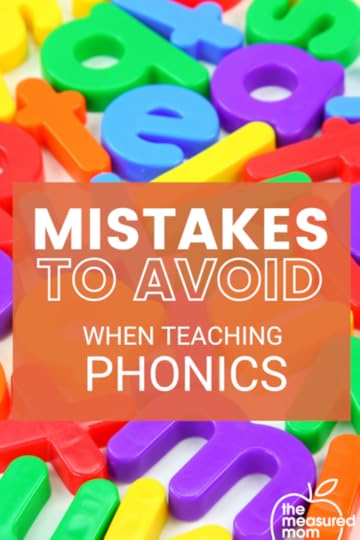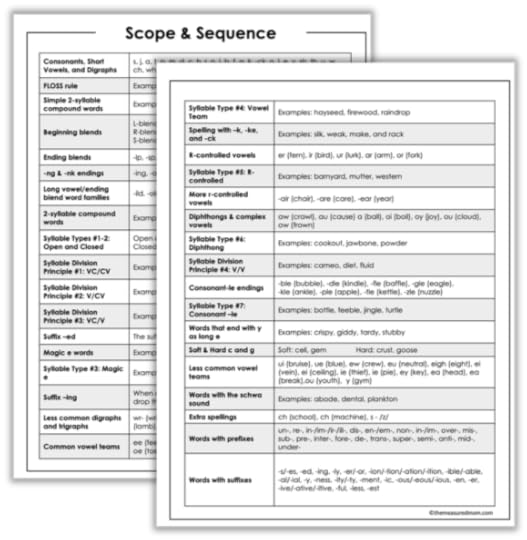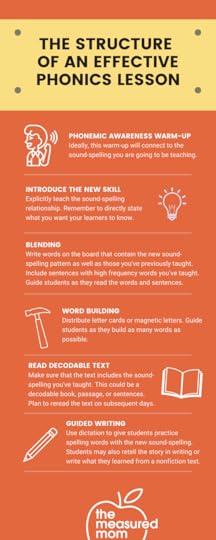Mistakes to avoid when giving phonics instruction
For decades I considered myself a balanced literacy teacher. Of course I believed in phonics instruction.
Of course I taught phonics.
Or did I?
Looking back, I made some pretty big mistakes when it came to phonics instruction.
I’m sharing them here in the hopes that I can help you avoid my own mistakes!
 Phonics Instruction Mistake #1: Not following a strong scope and sequence
Phonics Instruction Mistake #1: Not following a strong scope and sequenceAs a balanced literacy teacher, I had a general idea of which phonics skills were important to learn.
But I believed in an embedded approach to phonics instruction.
In other words, I taught phonics as it came up in our shared reading lessons, the students’ reading of leveled books, and our spelling lessons.
When students were stuck on a word, I (sometimes) encouraged them to find chunks they knew. If the word contained a sound-spelling they hadn’t yet encountered, I simply told it to them. (“ee” makes the long e sound)
Don’t get me wrong; it’s definitely helpful to point out sound-spellings during authentic reading and writing experiences.
BUT … this should be in addition to explicit phonics lessons that follow a strong scope and sequence.
By using a scope and sequence, we can ensure that we are not leaving gaps in our students’ phonics knowledge.
Get my free phonics scope and sequence below.
Free phonics scope and sequence
Sign up for our free newsletter and get this detailed phonics scope and sequence. You’ll know exactly what order to teach foundational phonics concepts!

Phonics Instruction Mistake #2: Not teaching phonics explicitly and systematically
I’ll be up front and tell you that my first year of teaching first grade, I was required to use a scripted phonics program that I hated.
It was a whole class program that, quite honestly, wasn’t meeting the needs of most of my students.
Because of that bad experience, I strongly believed in an embedded (rather than sequential, systematic) phonics approach. With the school board’s blessing, I tossed that program and, with it, explicit phonics teaching.
If I could go back (ahem) years, I would give engaging phonics lessons with the following elements:
 Phonics Instruction Mistake #3: Forgetting to incorporate phonemic awareness
Phonics Instruction Mistake #3: Forgetting to incorporate phonemic awarenessI’ll be honest. Phonemic awareness was hardly on my radar when I was a classroom teacher.
But these days, phonemic awareness is a hot topic in reading education … and with good reason! Of all the phonological awareness skills, phonemic awareness is by far the most important.
A child’s level of phonemic awareness has direct impact on his/her reading success.
A reminder: phonemic awareness is the ability to play with individual sounds in words; specifically, isolating, blending, segmenting, and manipulating those sounds.
We used to think that we should only do phonemic awareness “in the dark,” but now we know that incorporating letters is important.
Check out this video in which I share examples of incorporating phonemic awareness with phonics. (This is lesson 8 in our membership training, Phonological and Phonemic Awareness.)
The above video is an excerpt from the Phonological & Phonemic Awareness training of our membership site, The Measured Mom Plus.
Phonics Instruction Mistake #4: Not giving students enough practice with new sound-spellingsAs a balanced literacy teacher, I taught phonics within our spelling lessons. But looking back, I know that my approach was not nearly as robust as my students needed.
Most importantly, they lacked sufficient practice with new sound-spellings.
In spelling class, I taught my students to read and sort words with specific phonics patterns. But then I had them read leveled books during reading class. Since they yet didn’t know many of the sound-spellings in their leveled books, I told them to use context and the picture to help them “solve” words.
I wish I knew then what I know now.
Here’s the thing.
For kids who struggle to sound out words, they’re going to take the path of least resistance. They’re not going to use phonics to solve words if they can help it.
I wish, wish, wish that I had used quality decodable books instead leveled books with my beginning readers.
Decodable books help students actually apply their phonics knowledge.
I know, I know. A lot of decodable books are really the pits. But there are some incredible decodable book series out there, and more are published all the time.
Check out my Ultimate Guide to Decodable Books to find new favorites!
Phonics Instruction Mistake #5: Not teaching strategies for sounding out multi-syllable wordsI’m embarrassed to say that the only thing I remember teaching my students about multi-syllable words was to find chunks they know.
There’s so much more we can and should do!
1-Consider teaching students to read and identify syllable types (open, closed, magic e, vowel team, r-controlled, and consonant-le). To learn more, check out Reading Rockets’ article: Six Syllable Types.
2- Consider teaching syllable division strategies. There is debate about this in the science of reading community; some believe this is just too complicated and a waste of time.
I think the opposing side has a valid argument, but I don’t think we should toss it out entirely. We should be careful not to spend too much time on this, but I believe that teaching syllable division principles is valuable. To learn more, check out Sarah’s Teaching Snippets blog post: How to Teach Syllable Division Rules.
3- If the above is too much for you, I understand. Syllable types and syllable division principles can feel overwhelming or just plain unnecessary If you’re in that camp, make sure you teach your students a non-rule based approach for sounding out multi-syllable words.
I LOVE this video from Reading Rockets. If you’re short on time, watch it on double speed. It’s worth the 7 minutes!
Phonics Instruction Mistake #6: Failing to differentiateI love the enthusiasm I’m seeing from teachers all over the world about making their phonics instruction more explicit and systematic.
But in doing this, we have to be careful not to fall back into the old trap of thinking that teaching the same thing to everyone – all the time – is the way to go.
If you’ve been a teacher for a single day, you know how vastly different our students’ abilities are, especially when it comes to early reading skills.
Personally, I think that our students in kindergarten and first grade are best served by small group phonics lessons. To form these groups, we assess students’ phonics knowledge (check out my free phonics assessment – coming soon!) and group them accordingly.
In these small groups, we teach phonics systematically, sequentially, and explicitly.
If you’d like to know more about what those small group lessons could look like, stay tuned! It’s coming later in our phonics series.

Ultimate Collection of Phonics Word Lists
$15.00
After spending way too many hours searching for the right words, I created this ultimate collection of phonics word lists. With over 200 word lists, you’ll never have to google “words with the CVCE pattern” ever again!
Buy Now
The post Mistakes to avoid when giving phonics instruction appeared first on The Measured Mom.
Anna Geiger's Blog
- Anna Geiger's profile
- 1 follower



